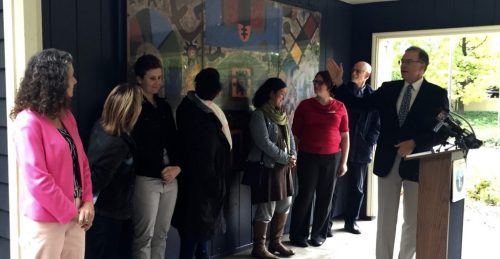Civil rights issues have intersected with restroom accessibility considerations for many decades.
Public restrooms have been a part of the United States' civil rights and gender conversation since they began to appear in modern public spaces in the early-1800s. An 1887 Massachusetts state law mandated the availability gender-segregated restrooms, which was considered a progressive win at the time because women were beginning to enter the workforce and face restroom availability discrimination based on gender. In present day society, however, these segregated restrooms are increasingly scrutinized for their lack of accessibility for those with non-binary gender identification and expression.
And it wasn't until the 1990 Americans with Disabilities Act that restrooms started to be constructed with disability access in mind. The facility modifications due to this national legislation have also benefitted those who need a larger space or additional support to use the restroom, including overweight persons, those who require assistance in using facilities, or families with small children.
In considering human rights and access to sanitation facilities, a growing number of municipalities/public sector agencies have upgraded their regulations to be more inclusive to all, regardless of their physical abilities, gender identity/expression, or body size.
The City of Portland, Oregon adopted an All-User Restroom Policy in November of 2015.

In November of 2015, Resolution 1339 was passed by the City Council in Portland, Oregon. Dubbed the "All-User Restroom Policy," this resolution stemmed out of an effort to remove inequities in restroom access revealed through surveys of City of Portland and Multnomah County employees. Testimony by members of Disability Rights Oregon served as a catalyst for a unanimous acceptance of the resolution by City Council. The resolution was initially introduced by the late City Commissioner Nick Fish, and its passing set in motion a careful action plan for upgrading and modifying the city's public restrooms to accommodate persons of all gender identities/expressions, persons of all body sizes, persons with physical disabilities, persons who may have personal attendants accompanying them in the restroom, and families with young children.
The first step in adopting this resolution was changing restroom signage to reflect "All-User" accessibility, and the next step was providing guidelines for construction of new facilities and the conversion of existing ones to accommodate all users. A ribbon-cutting ceremony for the first All-User Restroom occurred September 23, _2015 or 2016?__ at Dawson Park in North Portland. This ceremony was especially meaningful because only a few decades ago it was the site of segregated park toilets, underscoring the intersectionality and ongoing struggle for human dignity and basic rights we continue to face.
A listing of Portland-area parks with all-user accessible restrooms is available on the City website.
PHLUSH welcomes questions, comments, additions, and corrections to this listing.
Please contact us with any input.
Subscribe to our newsletter!
Announcement of Collaboration By Genevieve Mancuso of PHLUSH and Annika Lundkvist of Pedestrian Space PHLUSH is a nonprofit based in the United States that helps local governments and citizen groups to advocate for and provide equitable public restroom access. Pedestrian Space is a media platform…
In early May, Ashley and Genevieve traveled cross-country for a whirlwind week in Washington DC at the inaugural United States WASH (Water, Sanitation, and Hygiene) Convening! We’d like to thank our friends at DigDeep and Water For People for putting this incredible conference together, including funding for travel and lodging…
Professional photographer Mark Chester did not intentionally find the issue of inclusivity in restroom access - the issue found him. Chester began photographing restroom signs 12 years ago. In conducting this work, Chester began pondering the relationship between signage and inclusivity. What he found is that the barriers to equitable…
Announcement of Collaboration with Pedestrian Space!
A Recap of the U.S. WASH Convening: Part I
The Importance of Inclusive Restroom Signage
[show_twitter_feed]
